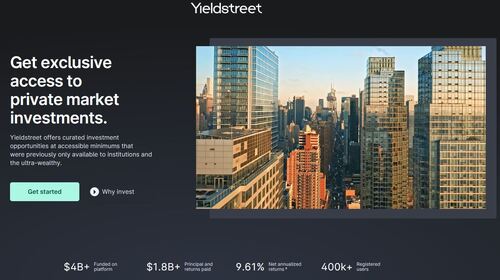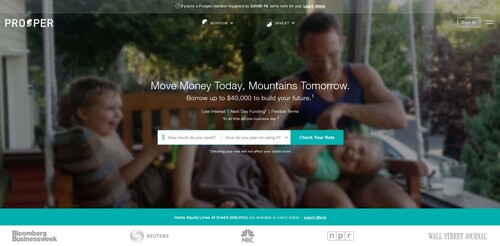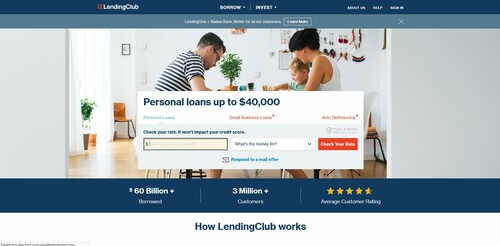USA's Top P2P Lenders for 2025
P2P Lending in the U.S.A
Peer-to-Peer lending began in the UK in 2005 before it came to the U.S in 2006. Lending Club was the first US P2P lender and has in many ways paved the way for P2P lenders in the USA. The lending service in the US is largely regulated by the SEC and is not directly available to all 50 states. Investors may have to seek alternative or 3rd party exchanges in order to purchase loan notes from the companies like Lending Club or Prosper.

Investors need to be accredited before investing on Peer-to-Peer lending platforms. They are also only allowed to legally invest 10% of their portfolio into P2P lending sites. Borrowers in the US generally request loan notes for debt consolidation or other forms of consumer loans. Many of them, offer loans with collateral, however, most do not. Unsecured loans are prevalent in US lending markets as credit ratings and risk are determined by credit score as opposed to collateral. On a brighter note, unsecured loans tend to have a higher interest rate.
In the US, P2P lending platforms generally use litigation as a form of fund recovery in the case of a defaulted loan. This is not ideal and should hopefully change in the future. Normally the problem with unsecured defaulted loans is that no collateral means that defaulted debt will have to be obtained through legal coercion.

Market Type
Alternative Investments
Average Returns
8 - 15%
Minimum Investment
USD 10,000
Signup Bonus
Various
Registered users
450,000
Total funds invested
USD 3.5 Billion
Default rate
2.5%
Regulating entity
U.S. Securities and Exchange Commission
Buyback guarantee
Secondary market
Payment methods
Bank Transfer, Bank Card, PayPal
Withdrawal methods
Bank Transfer, Bank Card, PayPal
P2PIncome reviews Yieldstreet, one of the very best alternative finance platforms in the world. Open to all US citizens, Yieldstreet is a multidimensional investment platform with everything from short-term notes and managed funds, to real estate and art. Learn whether Yieldstreet is right for you.

Market Type
Consumer Loans
Average Returns
6%
Minimum Investment
USD 25
Signup Bonus
USD 50
Registered users
Undisclosed
Total funds invested
USD 23 Billion
Default rate
3%
Regulating entity
U.S. Securities and Exchange Commission
Buyback guarantee
Secondary market
Payment methods
Bank Card, Bank Transfer, Credit Card
Withdrawal methods
Bank Card, Bank Transfer, Credit Card
Prosper is the first ever P2P lending platform to come out of the US. They are second in the US only to Lending Club. Prosper specializes in consumer loans, micro finance and debt consolidation.

Market Type
Consumer Loans
Average Returns
6 - 36%
Minimum Investment
USD 1,000
Signup Bonus
USD 25
Registered users
4.7 Million
Total funds invested
USD 85 Billion
Default rate
10%
Regulating entity
U.S. Securities and Exchange Commission
Buyback guarantee
Secondary market
Payment methods
Bank Transfer
Withdrawal methods
Bank Transfer
Lending Club is one of the oldest P2P lending platforms in the world. They are solely based in the USA. They are audited, publicly traded and fully compliant with SEC regulations.

Market Type
Charitable Loans
Average Returns
0%
Minimum Investment
USD 50
Signup Bonus
USD 25
Registered users
40,000
Total funds invested
USD 1.68 Billion
Default rate
4%
Regulating entity
Self-Regulated/SEC Compliant
Buyback guarantee
Secondary market
Payment methods
Bank Transfer, Credit Card, Debit Card
Withdrawal methods
Bank Transfer, Credit Card, Debit Card
Kiva is a P2P lending platorm built to help low income families find a consistent cash flow to survive. Lenders take no interest on the credit they provide but have the ability to lend out the same capital to multiple borrowers.
YieldStreet
Yieldstreet is one of the premier alternative-investment sites in the US. Yieldstreet investors have access to a vast array of offerings in several asset classes, including blue-chip art, insurance financing, REIT, cryptocurrency, legal financing, diversified funds, and more. The platform is regulated and audited by the SEC, and used third-party compliance officers to ensure everything remains above board.

Like other American peer-to-peer investment platforms, investors seeking access to the Yieldstreet marketplace must be accredited. However, Yieldstreet has set aside, while unaccredited investors can invest in the Prism Fund, as well as certain REIT options. The minimum investment in the Prism Fund is only $500, unlike the rest of the offerings, which begin at $10,000. Yieldstreet users can also managed their own (i.e. Self-Directed) IRA, for which many of the offerings are eligible.
To help streamline the investment process, Yieldstreet created its own Wallet, into which investors can deposit funds. The Wallet is insured for up to $250,000, though investors can deposit as much or as little as they want. Users with over $500,000 in investments are eligible for the Yieldstreet Diamond program. The Diamond program offers its own priority-support team, invitations to exclusive events, and first-call opportunities on new investments. The platform boasts Net Annualized Returns over 9.5%, with well over $4 billion funded. With nearly half of a million users, this is a platform that promises, and delivers, to both the middle and upper class.
Prosper
Prosper has generated over 17 billion USD in loans and has a historic return of roughly 5.5% interest. The minimum deposit on Prosper is a small 25 USD to start lending. On prosper lenders can fund both secured loans and unsecured loans. In other words, loans with collateral or without. The return is always adjusted based on the risk, so one can expect to receive higher returns on loans without collateral.

Prosper is compliant with FDIC and SEC regulations, they are incredibly transparent and have a very nice interface. Prosper mainly deals with debt consolidation and other forms of consumer loans. The idea behind prospers lending experience is that they wish to move away from sharing economies and start creating access economies, which is, economies that effectively decrease the barriers of entry to passive income and real economic independence.
LendingClub
LendingClub is by far the biggest P2P lender in the world. They have processed roughly 60 billion USD in loans on their site whilst reporting a default rate of roughly 8%. LendingClub is only available for investors in the US, who have a US social security, and phone number.

Lending Club started in 2006 and has been expanding ever since. The company is publicly traded and has remained somewhat profitable since its beginning of operations. LendingClub has received some scrutiny in 2016, due to the founder of LendingClub misconducting himself and manipulating LendingClub's book keeping to make LendingClub seem more profitable than it really was.
Lending Club deals with unsecured consumer loans primarily for debt consolidation.To further explain, people who need a loan for their credit card bills and have a stable income will most likely receive the opportunity to get a loan on Lending Clubs platforms. Unsecured loans mean that there is no collateral on the side of the borrower: interest rate and return are determined by the borrowers' credit score.
The better the credit score the lower the interest and the inverse also holds true. Unfortunately, LendingClub is no longer available to private retail investors. Due to the corona virus inflicted recession, LendingClub no longer has the resources it needs to operate.
Kiva
Kiva is a microfinance platform that provides real solutions to helping markets in third world countries flourish. Kiva is actually a loan originator aggregator in the US. They provide interest free loans that are given to individuals who truly need it, and who generally have a business that can pay back the loans. And, lenders feel as if they are lending money to people who without it would not survive. Kiva is in a way, a philanthropic way to lend money. Lenders do not make money with Kiva but find themselves just financially helping others at no cost.

Though, there is a unique aspect to Kiva which makes it financially enticing. Kiva has a considerably low default rate of only 6%. Lenders on Kiva find themselves investing 25 USD, getting it back paid in full and then reinvesting the same 25 USD to another borrower. Reinvesting your money on Kiva can be done twice, three times and so on. The same 25 USD can go on to affect 10 people, and the lender who put forth the money can take it back at the end of the loan duration.
Essentially, 25 USD can be lent out to 10 people. The money is sitting capital which can be so impactful if it's just sent through the right channels. This is a really powerful tool because it increases the value of money. For those who are truly passionate about helping smaller economies and economic circles, Kiva, is a great choice.
Defining P2P Lending
Peer to peer lending is a marketplace where individuals from all walks of society come together to borrow and lend money to one another. Before we entered modern society, the average man or woman was unable to easily earn an income through lending their money. In Europe, private lenders could only lend money if they were licensed and regulated by the local financial authorities of a given country. In the US, private lenders are subject to local/state regulation and lack of protection against borrowers who default. Peer-to-Peer lending has found its place in the spotlight due to the fact it gives all individuals the ability to safely lend their money.
Through peer-to-peer micro-financing and the collection of small payments from hundreds, thousands and in some cases even millions of people to help fund businesses around the world. As opposed to one investor or three investors funding companies for equity, hundreds of individuals can fund businesses through loans. Through these loans, individuals can find a return on their capital and borrowers can retain more equity in their businesses.
This does not just apply to businesses. That was simply an illustration to explain how P2P lending works in reality, P2P lending can be applied to any financial enterprise whether it be personal or professional.
Who Are US P2P Lenders For?
Peer-to-Peer lending sites in the US are for everyone in the US. The concept is to allow money to work for itself, even in small amounts. Investors and banks have traditionally profited nominal amounts by lending money, but P2P allows the average person to do the same, with the smaller sum he or she has.
The reality is that P2P lending can provide every class of society with another stream of money which helps bring people one step closer to financial independence.
It's a shame that only US citizens can participate with US P2P lending sites. By the same token, US P2P lending has a long way to go before the rest of the world might look to adopt it. There are other sites in Europe that offer the same interest rates, often higher, at a much lower risk. The US market still needs to find room to improve the security of their lenders' funds.
P2P Lending in Europe vs. U.S.A
The lending space in Europe is very different from the US. In the US, the lending minimums are higher, the interest rates are higher and the default rates are higher. The sentiment of everything in the US is just bigger, is true when it comes to Peer-to-Peer lending. They also pay the price for it.
In the US, P2P lending platforms are rife with defaulted loans. Litigation is the primary form of fund recovery which means every defaulted loan is reacted too with a stressful court procedure which takes months to settle. Not to mention the expenses end up costing a considerable amount. At the very minimum, 40% of the principal can be expected to be taken when a defaulted loan goes to court.
On the other side of the world, European P2P lending platforms are far more understanding and usually implement fund recovery strategies. Where they might extend the period of time to pay back the loan, reduce the interest rate, supply risk management strategies and resources in order to secure the lenders principal and the borrowers credibility. This is a far better approach. Litigation should honestly be a last resort. Some of the leading European websites when it comes to risk assessment and fund recovery are Mintos, October and PeerBerry.
Verdict
The US Peer-to-Peer investment ecosystem differs greatly from that of Europe, due in part to the US credit culture, and in part to government regulations. P2P lending websites in the US are only open to accredited US investors. Many American sites offer unsecured loans because the concept of credit in the US differs from the rest of the world. One consequence of collateral-free loans, however, is default rate of 8.5%. That means nearly one in ten investments flop, which is a horrible, wasteful experience for everyone involved.
As for accreditation, companies are technically obligated to required it, though enforcement seems sorely lacking. Federal regulation does not require extensive due diligence on the side of the company. Many US companies do not require their borrowers to submit physical proof of their income statement or net worth, as they simply rely on their stated net income and net worth. Nevertheless, the top platforms are extremely picky about their investors.
Yieldstreet, for example, conducts rigorous background and accreditation checks, making it an ideal site for high-end investors. That being said, their Prism Fund opens up a world of investment opportunities to small-time investors who might otherwise have to settle for stocks and bonds. With a minimum investment of only $500, the Yieldstreet Prism Fund is an excellent option, and the experts managing the fund take their job very seriously. It's for that reason that P2PIncome recommends Yieldstreet as the top platform for US investors.



